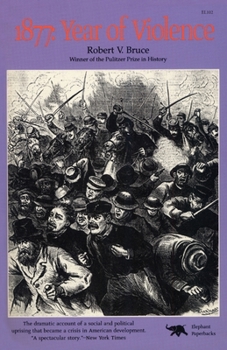1877: Year of Violence
Select Format
Select Condition 
Book Overview
Not simply a story of a year from our past but a dramatic account of a social and political uprising that became a crisis in the course of American development. "A spectacular story."-New York Times.
Format:Paperback
Language:English
ISBN:0929587057
ISBN13:9780929587059
Release Date:April 1989
Publisher:Ivan R. Dee Publisher
Length:384 Pages
Weight:1.05 lbs.
Dimensions:1.2" x 5.5" x 8.7"
Customer Reviews
2 ratings
Illuminating
Published by Thriftbooks.com User , 14 years ago
This book was out of print when I was writing my novel about 1877, and I was lucky to find it. It's now recognized as a classic of American history, and deservedly.
A Harrowing Time
Published by Thriftbooks.com User , 22 years ago
Originally published in 1959, Robert Bruce's "1877: Year of Violence" is a classic of sorts. Personally, I was drawn to this book because of its focus on that watershed year. Most undergraduate courses use 1877 as the explicit demarcation point between early and modern American history. Yet, I never quite understood why a plurality of professional historians had concluded that 1877 was the decisive inflection point in the history of our nation and hoped this book would shed some light on that issue.In the main, this book deals with the rise of big business (railroads, in particular) and the subsequent emergence of unionism and ultimately labor violence. That larger story is told through the specific events of the summer of 1877, when railroad workers reacted widely and violently - although not concertedly - to a wave of pay reductions by the major eastern trunk lines. In essence, the railroad executives had formed a quasi "union of capital," whereby each major trunk line agreed to lower wages by 15% one at a time throughout the summer and not to issue any rate wars in the interim while roads were putting down the inevitable strikes and walk-outs.The most shocking aspect of Bruce's narrative is the level of violence committed on both sides and the extremely precarious state of the nation at that time, both economically and politically. President Rutherford B. Hayes had come to office at the beginning of the year in a widely disputed election where he had secured a one electoral point victory over his Democratic challenger, New York Governor Samuel Tilden, but lost the popular vote and was ultimately declared the winner by an extra-governmental committee (sound familiar?). Moreover, the nation was just beginning to recover from the Panic of 1873, the worst economic contraction in American history to the time, while the South still smoldered from Civil War and was on the verge of all-out racial warfare as Reconstructionist policies were imposed from Washington. In short, the crisis facing the country was severe and it is a testament to the remarkable resilience of our republic that it survived such a widespread spasm of violence so shortly after a civil war, in the midst of extreme economic hardship, and under the leadership of a new, disputed and largely uninspiring chief executive.Bruce's writing style is crisp and direct, as one might expect to find in a book written by an academic in the 1950s. He avoids the showy dramatization common in contemporary popular history, but also steers clear of the dry, didactic prose of "more professional" histories. Those seeking a light, inspiring book to breeze through will likely be disappointed; however, those interested in getting a better understanding of a crucial, yet mostly forgotten epoch of American history will be satisfied and rewarded.






